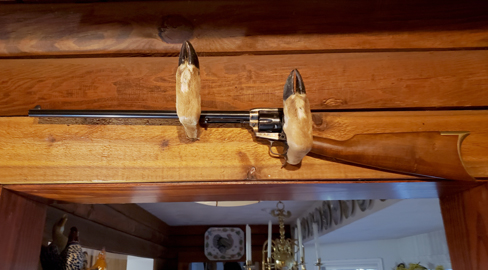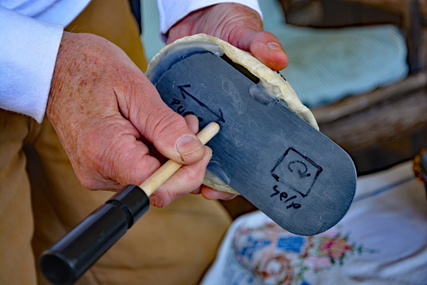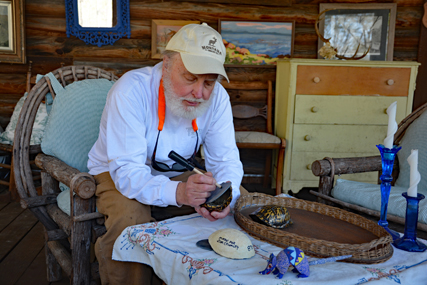Jim Crumley, Godfather of Modern Hunting Camo, Enjoying Life on Idyllic Virginia Mountain Retreat
- Ken Perrotte
- Jan 21, 2022
- 9 min read
Updated: Nov 25, 2022

Almost a half of a century has passed since an Alexandria, Virginia, schoolteacher named Jim Crumley began percolating an idea based on his belief that hunters needed more camouflage options than military surplus clothing. His first set of Trebark camouflaged clothing, sold in 1980, launched an industry, one that today embraces dozens of companies, including outdoor retailing behemoths Realtree and Mossy Oak.
Crumley was a teacher and later an administrator at T.C. Williams High School in Alexandria, the school famous for inspiring the 2000 film “Remember the Titans. An avid bowhunter, he hunted frequently at Marine Corps Base Quantico. He also spent many weekends guiding Eastern Shore goose and deer hunts.
He asked a friend, a Marine Corps sergeant at Quantico with a shared interest in turkey hunting, why the military didn’t make camouflage that was browner and grayer instead of patterns that had so much green in them. The sergeant explained that Armed Forces camo patterns were predicated on where the military thought it might have to fight overseas; not the woods of the United States. Such was the planting and taking root of the Trebark seed.

“Since 1972, the idea for a Trebark-type camouflage had been on my mind,” Crumley said. “It’s the kind of thing where just about everybody has said, ‘Why doesn’t someone invent a – something?’ And then the next day, you get a catalog and somebody already has,” Crumley said. “And you say, ‘Doggone it! I was thinking about doing that.' Every year, I’d get the Cabela’s catalog, looking to see if someone had invented it. They didn’t.”
Crumley began researching how to transfer art to fabric. In 1978, there was no such thing as computer-generated artwork or patterns. Everything was done from artwork, the designs transferred to fabric by a repeat roller process. His first suit of camouflaged garments was produced at the same time he was rejected for an inaugural doctoral program at George Mason University in 1979, one of 15,000-plus applicants for just 25 slots. It was a pivotal intersection of events is his life, one that would soon require some decisions.
“We got the first 10 yards printed and created a two-piece suit so I could do photography work. I still have a photo of me in that two-piece suit. I used it in the first advertisement in Bowhunter magazine,” Crumley said.
Orders began arriving. Crumley recalls his first order was from a King George, Virginia bowhunter named Johnny Buck, likely making Buck the first man in the world to buy a camouflaged outfit designed specifically for hunting.
Crumley took the magazine to Dr. Bob Harper, his boss at T.C. Williams. “I told him, ‘I think I’m going to retire from the school system,’" Crumley said. "I had been selling out of the back of my pickup truck, mostly, for about a year. After that ad ran, it sealed the deal. Harper said, ‘Well, it’s not the way I hoped things were going to work out…but if you get to the point you need investors, I would love to be involved.”

A year later, after Crumley took Trebark to his first SHOT (Shooting, Hunting and Outdoor Trade) Show. Orders rolled in, including a large purchase from outdoor retailing giant Cabela’s. Crumley needed capital, fast. “Dr. Harper was my first investor. We eventually doubled his money,” Crumley said with a big smile, before noting he bought out all of the original investors.
A Strong Run
For the next five years, it was military surplus camo and Trebark for hunters.
“We didn’t realize the impact we were making,” Crumley said. “Bill Jordan came along next with Realtree. That solidified that something was going on with hunter-specific patterns. The next year, Toxey (Haas) came out with Mossy Oak.”
He married his wife Sherry, a past Virginia Department of Game and Inland Fisheries Board chairwoman as well as a past member of the National Wild Turkey Federation’s national board, in 1985. They relocated to Roanoke where Crumley found more affordable warehouse space for Trebark. They bought a house and added a retail store called “Trebark Outfitters” to the warehouse operation.

Roanoke was home until 1990 when Crumley’s banker told him of a real estate opportunity, a 200-acre-plus expanse of gorgeous property in Botetourt. Crumley knew the area well. It happened to be adjacent to Westvaco paper company land Crumley had hunted for years. A day later, he bought it.
“From 1990 to 1991, this was our weekend getaway, a 45-minute drive from Roanoke,” Crumley said. “After a year of that, it was, ‘You know what? This is what we’ve always wanted. Your own piece of dirt. A house where you are hunting. You don’t have to drive anywhere if you don’t want to.’”
They sold the house in Roanoke and upgraded the log home already on the Botetourt property. They have since added 180 acres, including an old farmhouse along a creek. That dwelling is a guesthouse for friends and a rental property, often catering to anglers fishing the James River.
By the late 1980s, the camo market was on a moon-shot trajectory, backed with intense advertising, new television shows and hunting DVDs. In 2000, Crumley decided his 20-year run as an independent camouflage impresario – indeed, the innovator who launched the market - was long enough. He sold Trebark to Mossy Oak, staying connected to the business until 2010. For the next five years, he ran a gun dipping business, a process that adds camouflage patterns to firearms.
A Slice of Virginia Paradise
Springtime offers beautiful hunting opportunities. Colors erupt as nature wondrously awakens from winter dormancy. Few places rival, for instance, springtime Texas when wildflowers carpet the landscape unless, of course, you consider Virginia’s splendor of redbuds and dogwoods.
Redbuds were in their vibrant glory as I left Interstate 81 and began the peaceful climb into the mountains, heading toward the Crumley’s home, nestled near a ridgetop off a meandering gravel road. The plan was to hang out, enjoy a meal, and “catch up.” We might even try to find a cooperative wild turkey or two in the early morning.

The kitchen smells were incredible, especially as the oven door was opened. We inhaled the aroma of freshly baked muffins, with delicate redbud flowers the special ingredient. Reserved for next morning’s breakfast, they were delicious warmed and buttered.

Cooking is a passion for both Jim and Sherry. “I’m typically in charge of the meats and she
is in charge of the accoutrements,” he said. Venison, turkey, bear and squirrel are regular proteins on the menu. A substantial garden augments the wild game. “We do a lot of squirrels,” Crumley said. “I love September squirrel hunting. I think we’ve mastered – and even improved on - some of the squirrel recipes that my grandmother and mother did.”
Crumley ages all major cuts of venison in a small refrigerator converted for that purpose. He also grinds the meat from his wild turkey thighs, using it as he would ground venison, relishing it in burgers.
Bountiful, healthy wildlife only exists where there is quality habitat. The Botetourt property is an ongoing project for Crumley. He and his John Deere tractor are best friends and coworkers after shaping the habitat for three decades. Quality Deer Management Association principles largely drove many early land management decisions. Buck-to-doe ratios were “way out of kilter,” Crumley recalls. The property was “bowhunting only” for the first five years until Sherry, who preferred a rifle, decided to hunt. Deer herd and turkey populations have remained healthy and stable under his watch. Quail and grouse are also loving the landscape, in addition to a burgeoning population of black bears.
Crumley tries to annually plant a variety of trees, usually ones that will provide a variety nuts or other nutritious food for wildlife. He usually plants a small area to attract doves and isn’t afraid to experiment and try new wildlife plantings. He recalls planting chufa for turkeys one year, counting about 60 birds dining happily in the single plot. The next year, he planted five plots. Bears found those, deciding they, too, loved chufa. They ate the entire crop. He hasn’t planted chufa since.
Promoting “natural stuff,” as he calls it, like blackberries, pawpaws and persimmons, is a priority. Critters share the crops with the Crumleys. “We’ll bag them up, freeze them and eat them year-round," Crumley said. “When you read up on pawpaws, they have to be good for you. It is a hugely efficient fruit and it is one of the few Native American fruits.” The Crumleys freeze pawpaws whole with the skin on, which protects the flesh from freezer burn. Those treats get added to breads and even ice cream.

Today – ‘Hanging Around’
The Crumley’s home features a spacious great room, loaded with memorabilia and trophy animals Crumley took, all with bow and arrow, throughout North America. He used to travel extensively to hunt and was particularly fond of bowhunting elk. Those western elk trips, though, are in the rearview mirror. “That’s age related,” he shared.
Florida turkey hunting trips and winter goose hunts on the Eastern Shore remain on the docket. And when it comes to deer hunting, Crumley says, there’s no place like home. “I don’t enjoy anything more than deer hunting at home, waiting for that first morning of bow season,” he said.
Today, like many accomplished, seasoned hunters, Crumley is into selective, limited pursuits related to his primary passions. For example, he and Pat Harrison, a Covington, Virginia, hunting pal, decided they would turkey hunt together last spring under unique rules of engagement. Each could only use homemade calls crafted from slate and a box tortoise shell. “The birds did what they do to us,” he confided – meaning they didn’t cooperate.
“Life is mostly about our friends around here in Botetourt, our family, and getting the property ready for the next hunting seasons,” Crumley said, adding that they recently placed much of the property in a conservation easement, primarily to ensure it is perpetually maintained for wildlife. “So, now it’s just hanging around in Botetourt County on the James River,” Crumley said. “That’s mostly how I spend my time, on the tractor trying to make things better.” He and Sherry are active in the Botetourt Longbeards chapter of the NWTF and Virginia Hunters for the Hungry remains close to their hearts. “We’re life members of just about every conservation organization, but don’t do much traveling for them anymore,” Crumley said.

His chainsaw also gets regular workouts. The property is - or was - loaded with beautiful northern ash, the tree prized for making baseball bats. Many, though, are standing dead, killed by emerald ash borers. The insects are a scourge, decimating ash the way blight destroyed the magnificent chestnuts of Virginia’s mountains a century ago. Crumley said finding loggers willing to get these trees has been difficult. Consequently, his chainsaw stays revved as he cuts firewood for the wood stove, which generates most of the home’s heat in the colder months.
‘Told Ya’
Wearing an original Trebark vest, Crumley toted his 12-gauge over/under shotgun as he and I walked a ridge top on the property’s eastern edge, enjoying sunrise over the Blue Ridge. Sherry was hunting low grounds near a stream. Family friend, C.J. Davis, owner of the Montana Decoy Company, was hunting a ridge about ½-mile away. We were using some of Davis’ Purrfect Pair XD Turkey Decoys, at first curious looking with fabric over a spring-like frame, but effective and remarkably realistic once in position. The fabric better replicates a turkey's natural iridescence while taxidermy quality eyes add a finishing touch.

All gobbles we heard came from near the creek bottom or the opposing slope, though Sherry reported seeing no birds. Figures. Crumley said the toms usually fire up again around 9 a.m. so we rode in his souped-up golf cart for a leisurely tour of this mountain paradise, checking out the various plantings and habitat tweaks that make the property a wildlife wonderland.
Heading back for a final try at a turkey, we neared a hayfield where we spotted a bird earlier. Crumley made a couple yelps and, sure enough, a bird gobbled twice. It was 8:55 a.m.
“Told ya,” he said. Of course, though, those gobbles came from precisely where we began the morning, likely from a tom strutting his tail feathers off. Sneaking in would be tough – too tough it turned out. “Sometimes the gobblers win. I like it that way,” Crumley grinned.

A 50th...
Trebark debuted 41 years ago. I asked Crumley if the idea of a 50-year or some other commemorative resurrection of Trebark holds appeal. He noted that Mossy Oak Bottomland was Haas’ first pattern, later replaced by many variations. In the last couple years, though, Bottomland resurfaced as a highly popular pattern, enjoying new vigor as younger generations discover it. Maybe the same could be accomplished with Trebark.
“At some point, it might happen,” Crumley said. “It has been talked about in meetings but no decision that I know of has been made. It’d be neat. But 50 years…I don’t know whether I’ll make it that long.”
Here’s hoping. If it does, I want to maintain a King George, Virginia, tradition and buy that first set.

Note: A version of this article, along with a couple photos was published in the January-February 2022 issue of Virginia Wildlife magazine.












